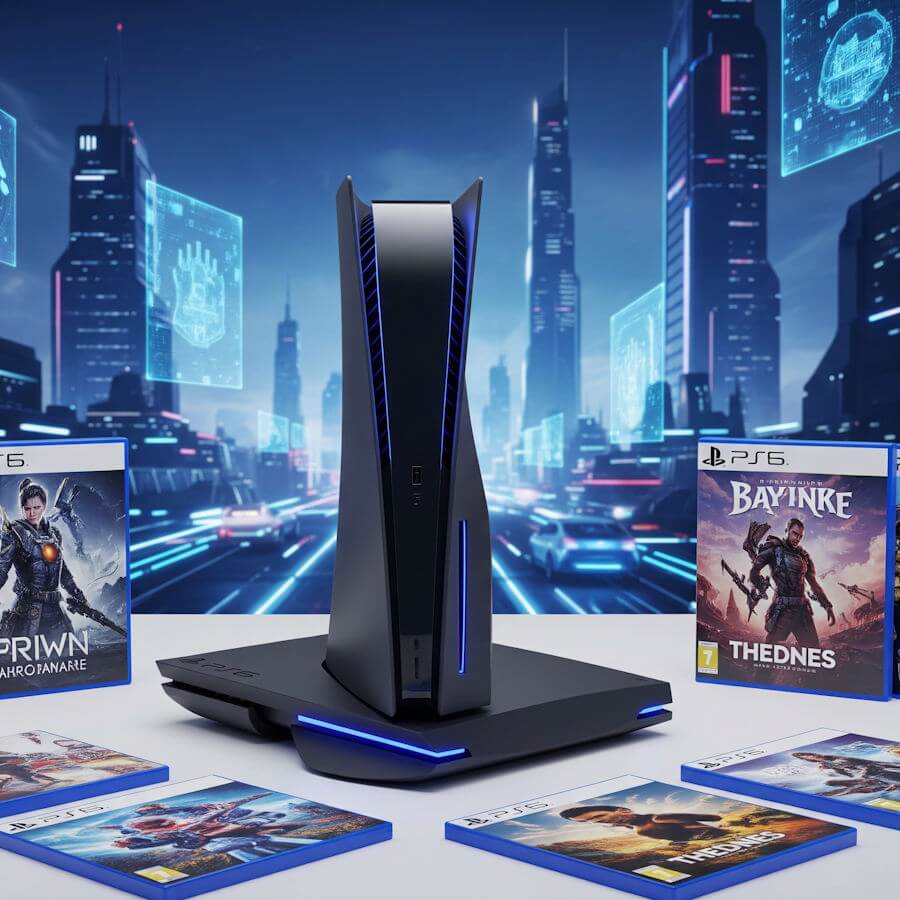The PlayStation 6, set to revolutionize the gaming landscape, is anticipated for release in late 2024. As the latest iteration in Sony’s iconic gaming console line, it boasts impressive hardware specifications designed to deliver a seamless and immersive gaming experience. Equipped with a custom AMD processor, the PlayStation 6 will feature advanced graphics capabilities, support for high resolutions, and enhanced frame rates, ensuring that players can enjoy lifelike visuals and fluid gameplay. One of its standout features is the integration of next-gen ray tracing technology, which allows for more realistic lighting and reflections, elevating the overall aesthetic of games.
Apart from its robust hardware, the PlayStation 6 distinguishes itself through its focus on connectivity and accessibility. With built-in Wi-Fi 6 technology, players will experience faster download speeds and smoother online gaming sessions. Additionally, the console will support a wide array of peripherals, including virtual reality devices, further expanding the potential for innovative gaming experiences. This emphasis on interactivity reinforces Sony’s commitment to fostering a connected gaming ecosystem.
In the context of gaming franchises, the PlayStation 6 serves as a critical platform that promises to enhance and expand beloved series while introducing new titles. Franchises such as “God of War,” “Final Fantasy,” and “Gran Turismo” have long been synonymous with PlayStation, and they continue to shape the gaming experiences of millions. With the advancements in graphics and technology, developers are empowered to push creative boundaries, crafting narratives and worlds that resonate deeply with players. Consequently, the importance of these franchises cannot be underestimated, as they contribute significantly to the PlayStation 6’s place within the gaming industry and its legacy among gamers worldwide.
Historical Context of PlayStation Franchises
The history of PlayStation franchises is a testament to the evolution of gaming itself. The original PlayStation console, launched in 1994, marked a significant step forward in gaming technology and introduced a variety of franchises that have left an indelible mark on the industry. Titles such as “Final Fantasy VII” and “Gran Turismo” emerged during this era, showcasing the potential for narrative depth and visual fidelity that CD-ROM technology allowed. These games not only captivated audiences but also set high standards for future game development.
With the arrival of the PlayStation 2 in 2000, franchises expanded further, with iconic installments like “Grand Theft Auto: Vice City” and “Metal Gear Solid 2: Sons of Liberty” pushing the boundaries of open-world gameplay and complex storytelling. This generation highlighted the PlayStation’s commitment to diverse gaming experiences, leading to a broader audience and defining new genres. The robust library established during this period paved the way for many sequels and spin-offs that would later dominate the market.
The launch of PlayStation 3 in 2006 ushered in a new wave of franchises that embraced online capabilities and high-definition graphics. Games such as “Uncharted” and “The Last of Us” not only showcased technical prowess but also emphasized character-driven narratives, enriching the gaming experience. These titles not only reinforced the PlayStation brand identity but also contributed substantially to the ongoing discourse regarding storytelling in video games.
The PlayStation 4 picked up this momentum, with franchises like “God of War” and “Horizon Zero Dawn” further evolving gameplay mechanics and visual storytelling. Each console generation built upon its predecessors, influencing both veteran franchises and new entries alike, ultimately enriching the gaming landscape and preparing it for the arrival of the PlayStation 6. Understanding this historical context is crucial in appreciating how far PlayStation franchises have come, setting the stage for what lies ahead.
Technological Advancements Influencing Franchise Development
The evolution of gaming on the PlayStation 6 is significantly shaped by technological advancements that have redefined how franchises are developed. One of the most prominent changes is the upgrade in graphics capabilities. With the introduction of advanced graphics engines, developers can create visually stunning environments that enhance the immersion of gameplay. High-definition textures, realistic lighting, and dynamic weather systems contribute to a vivid gaming experience, allowing franchise narratives to unfold in intricately detailed worlds, thereby engaging players on a deeper level.
Furthermore, advancements in artificial intelligence (AI) have transformed gameplay mechanics across various franchises. Enhanced AI systems allow non-player characters (NPCs) to exhibit more realistic behaviors and decision-making processes. This improvement facilitates complex interactions between players and the game world, enhancing storytelling through more believable character arcs and responses. For instance, franchise giants can now incorporate branching storylines that adapt to player decisions, creating a unique experience tailored to individual gamers.
Moreover, the faster processing speeds of the PlayStation 6 elevate the overall gaming experience. Developers can incorporate more expansive open-world designs, allowing players to explore vast environments without compromising performance. This speed facilitates seamless transitions between gameplay and cutscenes, resulting in a more polished and cohesive storytelling experience. Loading times are virtually eliminated, which is critical for franchises that rely heavily on narrative depth. As a result, gamers are now able to engage with multi-layered plots and diverse gameplay styles, reinforcing their investment in the franchise.
In sum, the combination of improved graphics, advanced AI, and heightened processing capabilities plays a crucial role in shaping franchise development on the PlayStation 6. These technological advancements not only enhance the aesthetic appeal of games but also create richer and more interactive storytelling experiences, ultimately pushing the boundaries of what players can expect from their favorite franchises.
Rising Indie Franchises on the PlayStation 6
As the gaming industry continues to develop, indie developers are carving out an increasingly important space for themselves within the ecosystem of gaming franchises. Set against the backdrop of the PlayStation 6, these small yet innovative teams are contributing unique narratives, gameplay mechanics, and artistic styles that collectively enrich the gaming landscape. Players are drawn to their creations due to the original concepts and fresh perspectives delivered through these indie games.
Notable titles such as “Hollow Knight: Silksong,” an anticipated sequel to its predecessor, showcase the ability of indie franchises to generate significant buzz within the community. Similarly, “Spiritfarer,” which invites players to take on the role of a ferrymaster for spirits, emphasizes narrative depth and emotional engagement, proving that smaller teams can indeed rival larger studios in storytelling. These franchises enhance the PlayStation 6’s repertoire, offering experiences that resonate with diverse audiences, particularly in terms of themes and character representation.
Moreover, indie franchises play a pivotal role in fostering diversity and innovation among game developers. The success of titles like “Celeste,” which touches on mental health issues, demonstrates a growing recognition of the importance of addressing complex subjects within gaming. This evolution marks a shift where indie games are not merely seen as alternative choices but as essential components of the gaming ecosystem that can stand shoulder to shoulder with long-established franchises.
With the PlayStation 6 providing a more robust platform for indie developers, these franchises are more accessible than ever. Enhanced marketing capabilities, distribution networks, and community support have empowered indie teams to reach larger audiences and compete more effectively. Their rise reflects a dynamic shift in gamer preferences, with a strong demand for originality, experimentation, and unique storytelling that traditional franchises may sometimes overlook.
Revival of Classic Franchises
The PlayStation 6 era has ushered in a remarkable trend: the revival of classic franchises that have significantly shaped the gaming landscape. As players seek familiarity during an age of rapid technological advancement, game developers have turned to beloved titles from previous generations. These franchises are not merely remastered; they are reimagined to meet the expectations of both nostalgic fans and new audiences.
One notable example is the revival of Final Fantasy, a series that has consistently garnered attention and acclaim. The reimagining of earlier titles, like Final Fantasy VII Remake, showcases enhanced graphics, modernized gameplay mechanics, and a deepened narrative. Such updates resonate with longtime followers while attracting newcomers who appreciate the evolution of the gaming medium. This approach has reinforced the franchise’s legacy, demonstrating that classic titles can thrive in a contemporary context.
Moreover, franchises such as Crash Bandicoot and Tony Hawk’s Pro Skater have also made comebacks with successful remasters that appeal to both veteran players and a new generation. The nostalgia factor plays a crucial role in these revivals, as players revisit their childhood favorites and experience them with improved visuals and gameplay enhancements. This blend of nostalgia and innovation can lead to increased emotional investment, making the gaming experience even more profound.
Importantly, the commercial success of these revived franchises is undeniable. Many have achieved high sales figures and positive critical reception, proving that there is a robust market for both nostalgic experiences and modern adaptations. The success of these games illustrates the potential of classic franchises when approached thoughtfully, reinforcing their place within the gaming culture. As we move forward in this new era, it is clear that the revival of classic franchises will continue to be a significant trend in the PlayStation 6 landscape.
Community and Online Integration in Franchise Evolution
The evolution of franchises on PlayStation 6 is marked by significant innovations in community engagement and online integration. One of the most noteworthy advancements is the incorporation of multiplayer functionalities, which has transformed how fans interact with their favorite franchises. This shift has led to a more dynamic gaming environment where players can collaborate or compete in real-time, enhancing the overall experience. The use of online multiplayer not only fosters a sense of community among players but also opens up avenues for developers to collect feedback directly from their audience.
Moreover, the adoption of live-service models has further revolutionized franchise offerings. These models allow games to receive continuous updates, new content, and seasonal events—keeping the community engaged over extended periods. This steady stream of content not only sustains player interest but also ensures that the franchises remain relevant in an ever-evolving gaming landscape. Through live services, developers have the flexibility to respond quickly to community preferences, further tailoring the gaming experience based on feedback gathered from players.
Another crucial aspect of this evolution is the direct incorporation of community feedback into the franchise development process. Developers are increasingly turning to forums, social media, and in-game surveys to gather insights from players. Such interaction enables them to understand better the desires and needs of their audience, leading to strategic improvements in both gameplay mechanics and narrative elements. By actively involving the community in development decisions, franchises can evolve in ways that resonate with their player base, creating a more personalized and engaging gaming experience.
The interplay between online integration and community feedback is reshaping the franchise landscape on PlayStation 6, paving the way for enhanced player satisfaction and loyalty. As franchises continue to evolve through these innovative structures, they remain exciting and relevant, ensuring a substantial role within the broader gaming community.
Adaptation to New Gaming Trends
Over the past few years, the gaming landscape has transformed significantly, compelling established franchises on PlayStation to adapt and innovate in order to remain relevant. Mobile gaming, for instance, has surged in popularity, attracting a diverse audience that craves gaming experiences on the go. PlayStation franchises have responded with mobile adaptations of their flagship titles, allowing players to engage with familiar narratives and characters on handheld devices. This approach not only expands the audience but also reinforces brand loyalty by providing multiple avenues for interaction with beloved franchises.
Similarly, the emergence of virtual reality (VR) has prompted game developers within the PlayStation ecosystem to explore immersive experiences that enhance player engagement. Franchises such as “Gran Turismo” and “Resident Evil” have successfully leveraged VR technology to deliver captivating, interactive environments that alter the gameplay dynamic. The introduction of VR capabilities has demonstrated how traditional gaming concepts can evolve, combining narratives with heightened immersion, ensuring that these franchises remain relevant in a continually shifting market.
Cloud gaming has also emerged as a transformative trend, offering gamers the ability to access high-quality titles without the need for extensive hardware setups. PlayStation has embraced this evolution through services like PlayStation Now, enabling players to stream various franchise-enhanced titles across multiple devices. This accessibility allows franchises to reach new audiences and provides long-time fans with the flexibility to enjoy their favorite games anytime, anywhere. However, this shift necessitates strategic adjustments in game development, focusing on optimizing titles for seamless cloud performance while maintaining the quality that consumers expect.
As these trends evolve, it is clear that PlayStation franchises are not just passively reacting to changes in the gaming ecosystem. Rather, they are proactively adapting their offerings to remain prominent players in an increasingly competitive landscape. The commitment to embracing such innovations is essential for the longevity of these franchises and ensures their continual relevance in the gaming community.
Critical Reception and Franchise Longevity
The relationship between critical reception and the longevity of PlayStation franchises serves as a crucial indicator of a franchise’s potential for sustained success. Many franchises that have achieved long-lasting popularity on the PlayStation platform owe their success to a combination of favorable reviews, player satisfaction, and consistent innovation. The initial critical reception often sets the stage for future installments; high review scores can significantly influence sales figures and player interest, leading to a virtuous cycle of continued development and support.
For instance, franchises such as “God of War” and “Final Fantasy” have enjoyed remarkable longevity, largely attributed to their ability to evolve while maintaining core elements that resonate with players. These franchises not only received critical acclaim upon their debut but have also consistently adapted to changing gaming landscapes. Updates in graphics, gameplay mechanics, and storytelling styles have drawn new players while retaining loyal fans. This responsiveness to player feedback and the broader market trend often correlates with favorable reviews, which serve to attract even larger audiences.
Conversely, franchises that fail to meet player expectations or experience critiques that highlight shortcomings can see a significant decline in their reception and, ultimately, their longevity. Titles that do not innovate or fail to connect with their audience may face diminishing sales, leading to fewer sequels or spin-offs. Moreover, the vast array of options available to players today means that competition is fierce. As such, franchises that do not continuously evolve risk fading into obscurity.
In summary, the critical reception of PlayStation franchises plays an integral role in determining their longevity. Franchises that achieved early acclaim, listened to player feedback, and continued to innovate typically enjoy enduring popularity, whereas those that do not adjust to player needs may struggle to survive in the competitive gaming market.
Future Directions for PlayStation Franchises
As we look towards the future of PlayStation franchises, several anticipated trends and developments are shaping the landscape of gaming. The evolution of technology, specifically the advancements in graphics and processing power, allows for more immersive experiences and richer narratives. The PlayStation 6, expected to leverage cutting-edge capabilities, is likely to enhance existing franchises while paving the way for new ones, capturing the interest of both long-time fans and new players alike.
One prominent trend is the rise of cross-platform gaming, which fosters a sense of community and shared gameplay experiences. Franchises that embrace this model seem better positioned to thrive. This trend may influence the development of existing titles, encouraging developers to integrate features that allow seamless interactions between platforms. Anticipated games such as the next iterations of “God of War” and “Horizon” are expected to incorporate such functionalities, expanding their reach while keeping the core audiences engaged.
Furthermore, there is an increasing focus on storytelling and character development, as gamers today often seek narratives that resonate on a personal level. We can expect upcoming franchises to invest heavily in compelling story arcs that intertwine with player choice and agency, allowing for a more personalized gaming experience. The possibility of branching stories and alternate endings could become more prevalent in future releases, enhancing replayability and player satisfaction.
Additionally, the gaming community’s growing interest in diverse representation is influencing franchise development. Future titles may introduce a wider array of characters, narratives, and settings that reflect global cultures and perspectives, broadening the appeal of PlayStation games. As emerging franchises make their debut, they are poised to challenge established norms and introduce innovative gameplay mechanics, ensuring that the PlayStation ecosystem remains dynamic and engaging.





